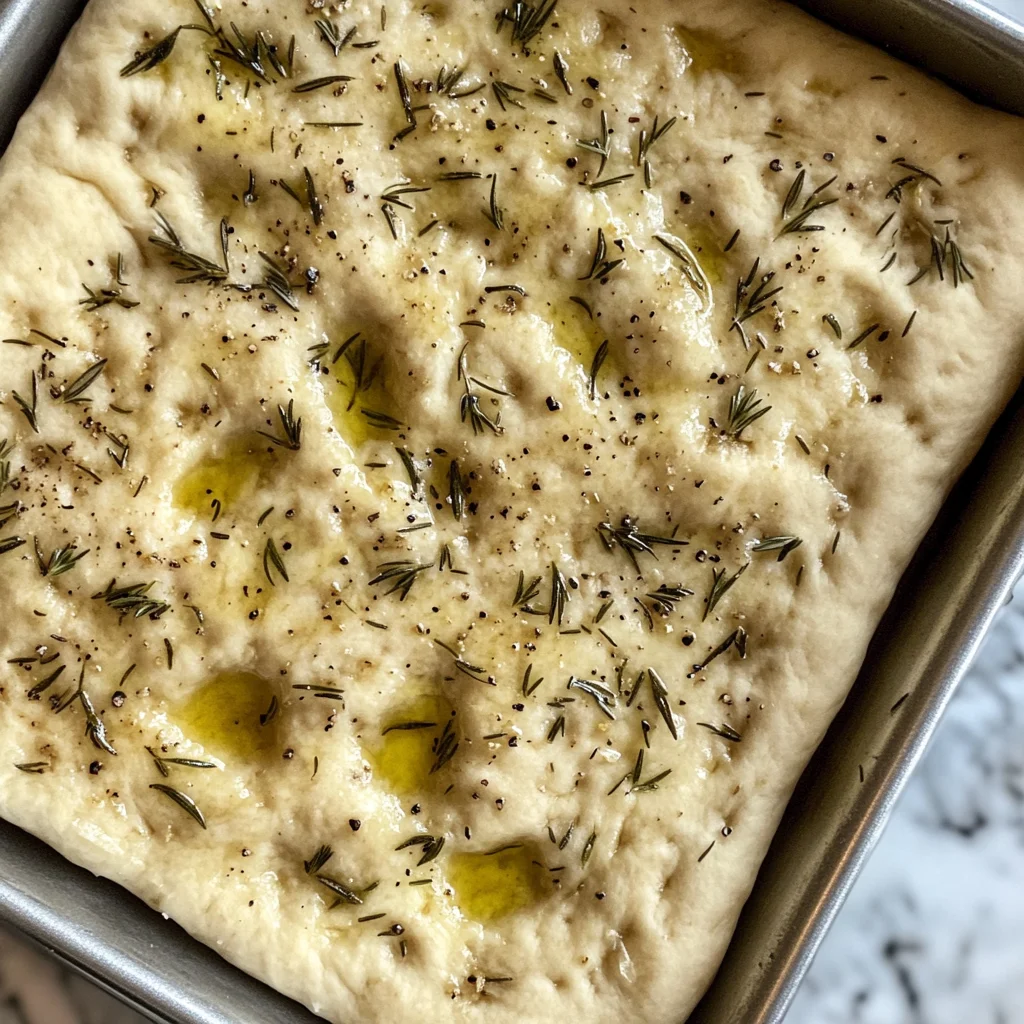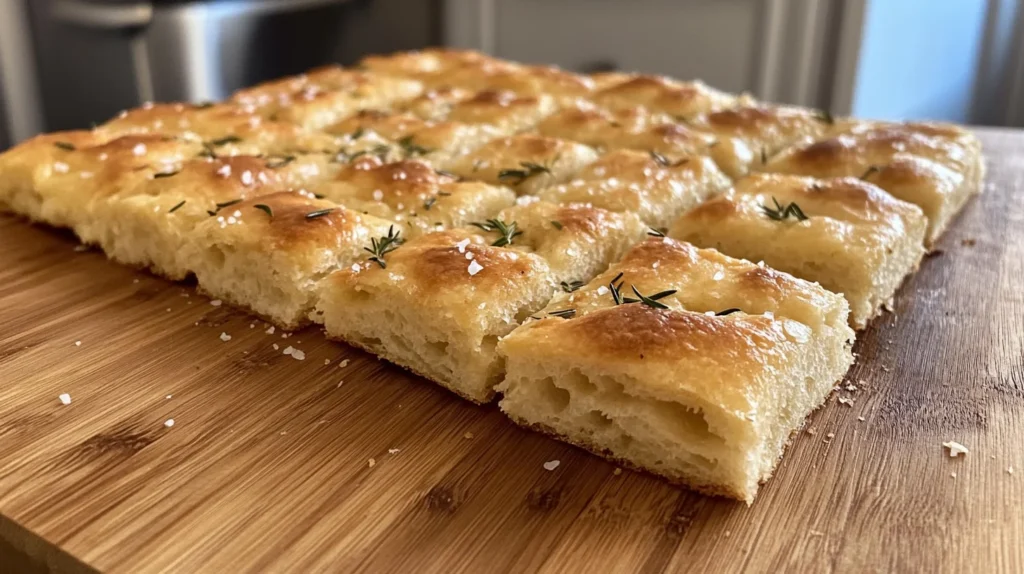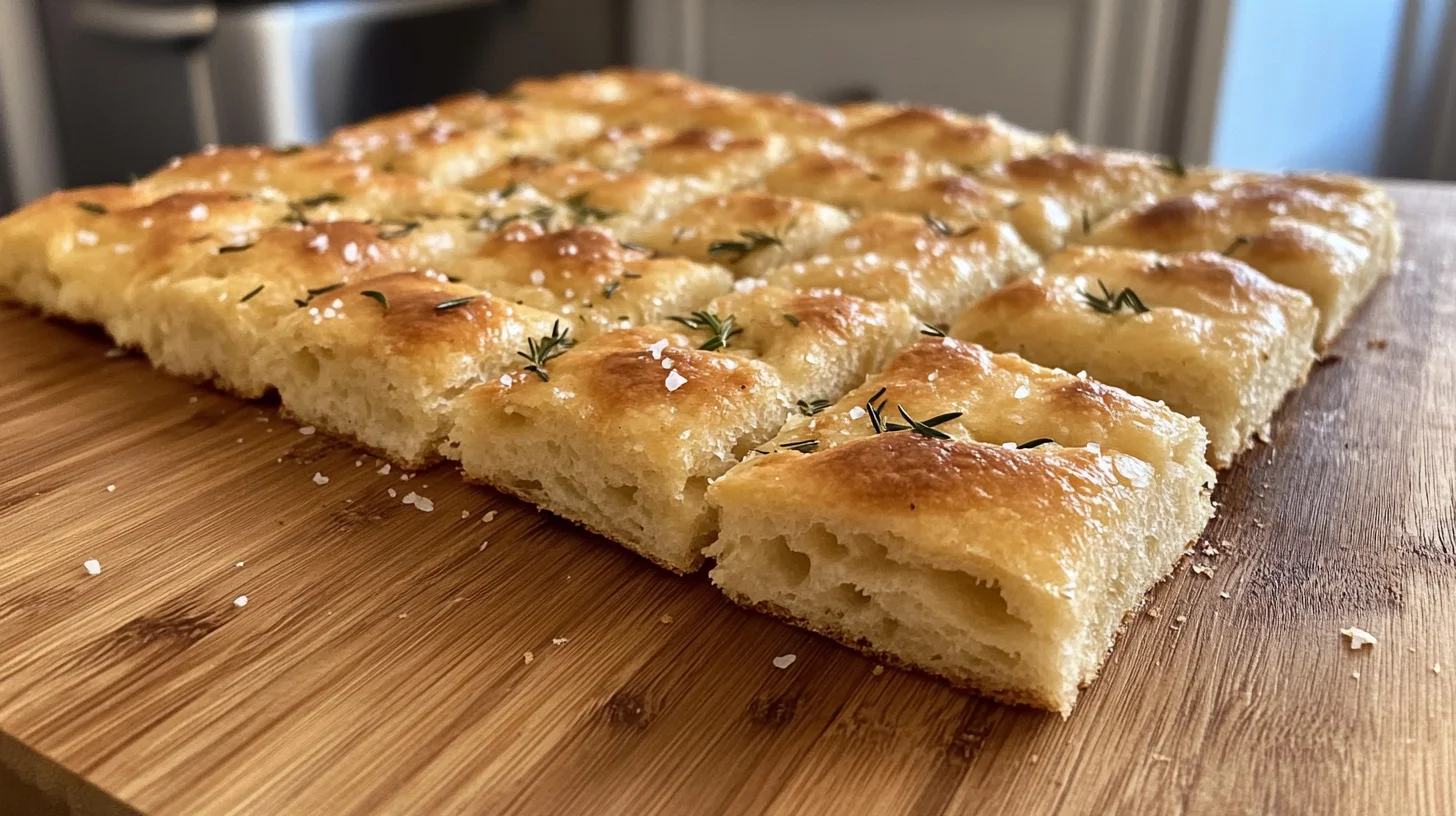Introduction to Sourdough Discard Focaccia
Yes, you can make focaccia with sourdough discard—and it’s downright delicious. If you’ve been feeding your sourdough starter and wondering what to do with the extra discard, this recipe is your new best friend. This sourdough discard focaccia recipe turns kitchen scraps into a fluffy, golden bread that’s perfect for snacking, dipping, or turning into a sandwich.
Focaccia is already known for its chewy texture, crispy crust, and olive oil-rich flavor. When you toss sourdough discard into the mix, you get a little tang, a touch of depth, and a great use for something that might otherwise go to waste. Plus, this version is beginner-friendly—no fancy techniques or fuss. Just some patience while the dough does its thing.
Whether you’re new to sourdough baking or just want a simple way to use discard, this focaccia has your back. It’s one of those easy wins that feels fancy but comes together without much effort. Keep reading to learn what you’ll need and how to pull it off step-by-step.
Ingredients You’ll Need
Here’s everything you’ll need to make this easy sourdough discard focaccia at home. The ingredients are simple and pantry-friendly, but the flavor? Big-time payoff.
- 1 cup sourdough discard (unfed, straight from the fridge is fine)
- 2 ½ cups all-purpose flour
- 1 teaspoon salt
- ¾ cup warm water (about 100–105°F)
- 1 teaspoon instant yeast
- 2 tablespoons olive oil (plus more for drizzling)
- 1 teaspoon honey or sugar (optional, but helps feed the yeast)
Optional toppings:
- Coarse sea salt
- Fresh rosemary or thyme
- Sliced olives, cherry tomatoes, or caramelized onions
- Grated parmesan or crumbled feta
- Crushed garlic or garlic powder
This base is super forgiving, and you can adjust toppings based on what you’ve got in your fridge or pantry. Now that your ingredients are lined up, let’s talk tools and how to make it all happen.
Now that you’ve got everything ready, let’s walk through this easy sourdough discard focaccia recipe step by step.
Kitchen Tools and Equipment
You don’t need anything fancy to make sourdough discard focaccia—just a few basic kitchen tools will get the job done. Here’s what you’ll want to have on hand before you get started:
- Large mixing bowl: This is where your dough will come together and rise. Bigger is better to give the dough room to expand.
- Measuring cups and spoons: Accuracy matters for the right dough texture, so level off your flour and measure liquids carefully.
- Wooden spoon or silicone spatula: For mixing the dough without making a huge mess.
- Plastic wrap, reusable cover, or a clean towel: To cover the dough during its rising time. Keeps moisture in and drafts out.
- 9×13 baking pan or sheet pan: A standard metal baking pan works great here. If you want a thicker focaccia, use a smaller pan; for thinner, use a bigger one.
- Parchment paper (optional): This makes it easier to lift out the focaccia and clean up afterward, especially if your pan isn’t nonstick.
- Pastry brush or spoon: To spread olive oil evenly across the dough and pan.
- Your hands: Yes, you’ll need to get in there and dimple the dough. That’s part of the fun—and it helps create those iconic focaccia bubbles.
If you’ve got all of the above, you’re ready to get baking. Now let’s walk through each step, from mixing to baking, so your sourdough discard focaccia comes out just right.
Step-by-Step Guide to Making Sourdough Discard Focaccia
Step 1: Mix the dough with sourdough discard
Start by grabbing a large bowl. Add your sourdough discard, warm water, honey or sugar (if using), and instant yeast. Stir to dissolve and combine.
Next, add the flour and salt. Mix everything together until you get a rough, sticky dough. It’ll be a little shaggy—totally normal. You’re not kneading it like traditional bread, just stirring until everything’s incorporated.
Drizzle a little olive oil on top, then cover the bowl with plastic wrap or a clean towel. Let it sit for about 15 minutes to relax.
Step 2: Let it rise (bulk fermentation)
After the dough has had its short rest, give it a few folds right in the bowl—pull one side up and fold it over the middle, turning the bowl as you go. Do this 3–4 times. It helps build a bit of structure.
Now cover it up again and let it rise at room temp for 1 to 2 hours, or until it’s doubled in size. If your kitchen is chilly, this might take a little longer. You’ll know it’s ready when it’s puffy and jiggly.
You can also do a slow rise in the fridge overnight. Just cover and chill—this adds even more flavor, especially with sourdough discard in the mix.
The long fermentation in this sourdough discard focaccia recipe helps develop flavor and that signature airy crumb.
Step 3: Prep your pan with olive oil
Generously coat your baking pan with olive oil—bottom and sides. This gives the focaccia that crispy, almost fried bottom that everyone loves.
If you’re using parchment, lay it down in the pan and drizzle more oil on top. Either way, your dough should slide around easily and soak up that oil during baking.
Step 4: Stretch and dimple the dough
Once the dough has risen, gently transfer it to your prepared pan. Try not to punch it down too hard—you want to keep those airy bubbles.
Use your fingers to stretch it toward the edges of the pan. If it’s resisting, let it rest for 5–10 minutes and try again. Dough can be stubborn like that.
When it’s spread out, use your fingertips to press deep dimples all over the surface. Press down like you’re poking holes in playdough—it’s fun and essential for texture.
Step 5: Add toppings and bake to golden perfection

Drizzle more olive oil over the top (don’t be shy), then sprinkle on your toppings. Sea salt, rosemary, tomatoes, olives—go wild or keep it simple.
Let the dough rest again for 20–30 minutes while your oven preheats to 425°F (220°C). This gives it one last little puff before baking.
Bake on the middle rack for 25–30 minutes, or until the top is golden and the edges are crispy. Keep an eye on it around the 20-minute mark—every oven’s a little different.
Let it cool in the pan for a few minutes, then transfer to a wire rack or cutting board. Serve warm, dip it in olive oil, or use it as the base for an epic sandwich.
Flavor Tips and Creative Variations
One of the best parts about this sourdough discard focaccia recipe is how customizable it is. The base recipe is super forgiving, and once you get the hang of it, you can make it your own every single time.
Start simple by adding fresh herbs to the dough. A little chopped rosemary, thyme, or basil mixed in before the first rise brings a whole new depth of flavor. If you like a little heat, toss in a pinch of crushed red pepper flakes or a spoonful of minced garlic.
Want something on the savory side? Press in toppings like sliced red onion, pitted olives, sundried tomatoes, or even thinly sliced potatoes tossed in olive oil. Cheese lovers can sprinkle parmesan, asiago, or mozzarella on top before baking for a gooey, golden finish.
For a sweet-and-savory twist, try figs and goat cheese, honey and sea salt, or even sliced grapes with a sprinkle of rosemary. It might sound fancy, but these combos are ridiculously tasty and easy to pull off.
If you’re feeling adventurous, swap part of the flour for whole wheat or rye flour for a deeper, earthier taste. Just be sure to keep some all-purpose flour in the mix so the texture stays soft and chewy.
Focaccia made with sourdough discard also plays well with dips and spreads. Serve it alongside balsamic vinegar and olive oil, hummus, pesto, or creamy whipped feta. The possibilities are endless, and the leftovers (if there are any) make amazing sandwiches the next day.
If you love warm, spiced bakes, you might also enjoy this classic Libby’s pumpkin bread recipe—perfect for cozy fall flavors.
Common Mistakes to Avoid with Sourdough Discard Focaccia
Even though this recipe is laid-back, a few little missteps can mess with the texture or flavor of your focaccia. Here’s what to look out for:
1. Not using enough oil.
Focaccia needs a good glug of olive oil—not just for flavor, but for that crispy bottom crust. If your dough sticks or turns out dry, it might be because you skimped on the oil.
2. Underproofing or overproofing.
Letting the dough rise just right is key. If it doesn’t rise enough, it’ll be dense. If it rises too much, it might collapse or bake up flat. Keep an eye on the dough’s size and texture—it should be soft, puffy, and jiggly before you bake.
3. Using cold discard straight from the fridge without adjusting timing.
Cold starter slows things down. You can totally use it, but be prepared to let the dough rise longer to make up for it. Or let the discard come to room temp first.
4. Skipping the dimpling step.
Those little pockets in the dough aren’t just for looks—they help catch toppings and keep the dough from puffing up unevenly in the oven. Don’t skip it, and don’t be shy about pressing deep.
5. Overloading with toppings.
It’s fun to go wild with add-ons, but piling on too many wet or heavy toppings can lead to soggy focaccia. Stick to a few well-chosen ingredients and scatter them evenly.
Avoiding these common mistakes makes a big difference—especially when you’re working with the unique texture of sourdough discard. The good news? This bread is super forgiving, so even your “oops” batches will still taste pretty great.
Nutritional Perks of Using Sourdough Discard
This sourdough discard focaccia recipe offers more than great flavor—it has some subtle nutritional benefits, too. While it’s not a magic ingredient, it does offer some small boosts compared to standard white bread.
For starters, sourdough discard contains natural acids and beneficial bacteria from the fermentation process. Even though the discard isn’t freshly fed, it still carries traces of wild yeast and lactic acid bacteria. These can help make the gluten and starches in the dough a bit easier to digest for some folks.
Another plus? The longer rise time often used with discard-based recipes gives the flour more time to break down phytic acid, which can block the absorption of minerals like iron and zinc. When that acid breaks down, your body can make better use of the nutrients in the flour.
Also, because this focaccia doesn’t rely entirely on added yeast, it can have a lower glycemic index than traditional white bread—especially if you let the dough rise slowly in the fridge. That means it might not spike blood sugar as quickly, which is good news if you’re trying to keep energy levels steady.
If you mix in some whole grain flours, nuts, seeds, or veggie toppings, you can bump up the fiber, healthy fats, and micronutrients even more. Things like flaxseeds, olives, or roasted peppers can make your focaccia feel more like a smart snack than a guilty pleasure.
Of course, focaccia is still bread—and it’s not low-calorie or carb-free—but using sourdough discard is a small way to make your homemade version a bit more wholesome. And hey, you’re also cutting down on food waste, which is a win in itself.
This cranberry quick bread is another great baking idea if you’re looking for something fruity, sweet, and super snackable.
How to Serve and What to Pair It With
This sourdough discard focaccia is super versatile, and the way you serve it can totally change the vibe of your meal. Whether it’s a side dish, a snack, or the star of the show, here are a bunch of ideas to get you started.
For snacking or appetizers:
Slice it into strips or squares and serve it with a little dish of olive oil and balsamic vinegar. You can also set it out with a small spread of dips—hummus, white bean dip, or even a garlicky aioli go great with the tangy, chewy bread.
As a side dish:
Focaccia pairs beautifully with soups and stews. Try it with tomato basil soup, creamy potato leek, or even chili. It’s also a hit alongside big salads like Caesar, Greek, or a grain bowl topped with roasted veggies.
Turn it into a sandwich:
Cut your focaccia in half lengthwise and layer it with meats, cheeses, veggies, or spreads. Think turkey and provolone, roasted red peppers with mozzarella, or hummus and cucumbers. The chewy texture holds up really well to fillings.
For breakfast or brunch:
Toast leftover focaccia and top it with scrambled eggs, avocado, or even a fried egg and bacon. You can also make a focaccia breakfast sandwich or use it as the base for mini flatbreads with cheese and herbs.
To round out a dinner spread:
Use your focaccia to mop up sauces or serve it next to pasta dishes, braised meats, or roasted chicken. The olive oil-rich dough works like a sponge for any flavorful juices or gravies on the plate.
No matter how you serve it, this bread has a way of disappearing fast. It’s the kind of thing that makes any meal feel a little more special without much extra effort.
This focaccia also works great for brunch spreads—think fried eggs, roasted veggies, or even alongside dairy-free waffles for a cozy weekend combo.
Frequently Asked Questions
You might still have questions about working with this sourdough discard focaccia recipe, so here are answers to the most common ones.
Can I use sourdough discard for focaccia?
Absolutely! Sourdough discard is perfect for focaccia. It adds a mild tangy flavor, extra depth, and helps reduce waste from regular starter feedings. The discard won’t make the bread rise on its own, but when combined with a bit of commercial yeast, it creates a soft, flavorful dough that’s easy to work with.
Can I turn my sourdough bread into focaccia?
Not quite. Sourdough bread dough is usually firmer and shaped for loaves, while focaccia dough is much wetter and baked flat. However, you can use your sourdough starter (or discard) as part of a focaccia dough recipe. Just follow a focaccia-specific formula like this one that’s built to handle that added moisture and acidity.
Can you make bread from sourdough discard?
Yes, you sure can. While discard alone doesn’t have enough active yeast to make bread rise like a fed starter would, it’s great for adding flavor and structure when combined with other leaveners. Many folks use it in things like pancakes, crackers, muffins, and of course, breads like this focaccia.
What can I make with sourdough starter discard?
Tons of things! Sourdough discard is super versatile. Aside from focaccia, you can mix it into recipes for waffles, biscuits, tortillas, crackers, banana bread, pizza dough, or even cookies. Basically, anything that uses flour and water can often be adapted to include a little discard for flavor and texture.
This banana bread also uses leftovers in a smart way—check out this no-butter banana bread recipe for a sweet way to use up your kitchen staples.
How long can I keep sourdough discard before using it?
Discard can usually be stored in the fridge for up to a week. Some bakers even keep a running jar and add to it each time they feed their starter. If it smells really sharp, like nail polish remover, or has any mold, it’s time to toss it. Otherwise, if it just smells tangy or yeasty, you’re good to go.
Do I need to let the dough rise overnight?
Not necessarily. You can do a quick rise in a couple of hours, but if you want deeper flavor, refrigerating the dough overnight helps. It also makes scheduling easier since you can prep ahead and bake the next day. Either way, the sourdough discard still shines.
Can I freeze sourdough discard focaccia?
Yes! Once baked, let the focaccia cool completely, then wrap it tightly in foil or plastic wrap and freeze for up to a month. To reheat, pop it in a warm oven (around 350°F) for 10–15 minutes. It’ll taste almost as fresh as the day you made it.
Why didn’t my focaccia rise much?
A few things could be going on. Your yeast might be old, your discard too cold, or your kitchen temperature too low. Also, if the dough overproofed (rose too long), it can deflate before baking. Make sure your yeast is active, and give your dough enough—but not too much—time to rise.
Final Thoughts on Baking Focaccia with Sourdough Discard
This sourdough discard focaccia recipe is one of those easy, go-to bakes you’ll want to make again and again. Even if you’re new to sourdough or don’t bake often, this recipe is super approachable and forgiving. You don’t need any special tools or experience—just a bowl, a pan, and a little time.
The discard gives the bread a gentle tang that sets it apart from regular focaccia, and the olive oil makes the crust golden and crisp while keeping the inside fluffy. It’s the kind of bread that impresses guests but doesn’t stress you out to make.
Plus, once you’ve tried it, you’ll probably start experimenting with toppings and mix-ins, making this recipe feel new every time. It’s a great way to get more out of your sourdough starter without having to bake full loaves constantly.
So next time you’re wondering what to do with that leftover discard, remember: focaccia’s got your back. It’s simple, it’s satisfying, and once you taste that first warm bite, you’ll be glad you gave it a go.


